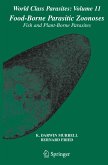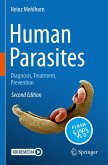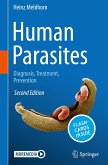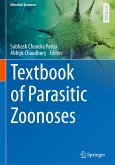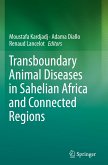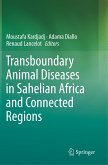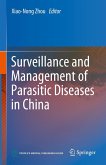Humans suffer from numerous parasitic foodborne zoonoses, many of which are caused by helminths. The helminth zoonoses of concern in this book are normally limited to diseases of animals which have now become transmissible to humans. In the past these diseases were limited to populations living in low- and middle-income countries, but the geographical limits and populations at risk are expanding and changing because of growing international markets , improved transportation systems, and demographic changes (such as population movements). The World Health Organization (WHO) has estimated that the number of people currently infected with food borne trematodes alone exceeds 41 million, but worldwide the number of people at risk, including those in developed countries, is 750 million. The increasing recognition of the public health significance of these zoonoses, especially their complicated epidemiologies, and their links to poverty, intensification of agriculture, environmentaldegradation, and lack of tools for control- has been welcome. However, the development of priorities for a national public health system is often a competitive exercise, and the argument for devoting appropriate attention and resources to foodborne parasitic zoonoses is generally handicapped by the lack of good health and economic impact data. The genesis of this book was a desire to draw attention to the problem of these zoonoses and to hopefully, inspire greater efforts to acquire a reliable global impact assessment and therefore a basis for improved prevention and control actions for these zoonoses.
This book reviews not only the prevalence and distribution of these zoonoses, including available health and economic impact data, but will highlight gaps in knowledge that must be filled in order to gain the assessment needed to depict the overall importance of a particular zoonosis. This is critical for comparisons to other pressing public health and development needs in resource allocations. The topics on epidemiology, diagnosis, and clinical aspects emphasize the knowledge gaps that limit a full understanding of these zoonoses, and target where greater research investments on these parasitic diseases should be focused.
This book reviews not only the prevalence and distribution of these zoonoses, including available health and economic impact data, but will highlight gaps in knowledge that must be filled in order to gain the assessment needed to depict the overall importance of a particular zoonosis. This is critical for comparisons to other pressing public health and development needs in resource allocations. The topics on epidemiology, diagnosis, and clinical aspects emphasize the knowledge gaps that limit a full understanding of these zoonoses, and target where greater research investments on these parasitic diseases should be focused.
PUBLISHED IN THE SEPTEMBER 2008 ISSUE OF EMERGING INFECTIOUS DISEASES
Food-Borne Parasitic Zoonoses: Fish and Plant-Borne Parasites
(World Class Parasites)
K. Darwin Murrell and Bernard Fried, editors
Springer, New York, New York,
USA, 2007
ISBN-10: 0387713573
ISBN-13: 978-0-387-71357-1
Pages: 686; Price: US $169
With >4,000 biomedical journals currently available, and more being added seemingly every month, one of the most overwhelming and daunting tasks for any health professional is to stay current with the literature. A welcomed lifeline has been the World Class Parasites series of publications that have made this challenge much easier to manage. The latest text (Volume 11), Food-Borne Parasitic Zoonoses: Fish and Plant-Borne Parasites, is a superb addition to this series. Murrell and Fried have brought together a stellar group of contributors In a comprehensive and up-to-date review of the helminthic zoonoses that are transmitted through fi sh and plant consumption. Given that the distribution and effect of these zoonoses remain woefully underappreciated, they Are deserving of the justifiable attention brought by this book.
The first 9 chapters provide a thorough discussion of intestinal, Liver, and lung flukes; fish-borne tapeworms; and tissue nematodes. Two superb chapters on immunologic aspects and molecular epidemiology of these parasites complete the text. There is much to extol in this volume. In an era of justifi able focus on molecular biology and genetics, it is heartening to see the broad-based and integrated approach taken by the editors and collaborators. This approach successfully accomplishes the stated objective of the editors to "... celebrate the diversity of approach that comprises modern parasitological research." The chapters are clearly written and well organized with a balanceof both classic, historic articles as well as important recent work.
The editors and authors have obviously made a priority of ensuring that the material is widely accessible to scientists and health professionals in diverse disciplines. They have presented detailed information on the biology, life cycles, natural history, diagnosis, treatment, epidemiology, and control of the agents or infections discussed. Current diagnostic techniques are thoroughly addressed. Insightful discussion is provided at the end of each chapter on current gaps in knowledge and research needs that offers a coherent roadmap for future studies. The chapter on intestinal capillariasis by Cross and Belizario is particularly noteworthy. Abundant images of exceptional quality are included and this adds substantially to the text. More color images would have been of value, but they may have made the text prohibitively expensive. Some chapters could have had additional discussion of epidemiologic aspects and a few typos can be found, but these do not diminish the value of this outstanding work.
Food-Borne Parasitic Zoonoses: Fish and Plant-Borne Parasites is a text of exceptional quality that should have broad appeal and utility for health professionals, researchers, medical and public health students, and policy makers. Given the increasing interest in neglected tropical diseases, this book is a timely and commendable work that will promote efforts to reduce the effects of these parasitic agents.
Frank J. Sorvillo
Author affiliation: University of California,
Los Angeles, California, USA
DOI: 10.3201/eid1409.080495
Address for correspondence:
Frank J. Sorvillo,
Department of Epidemiology, School of Public
Health, University of California, Los Angeles,
CA 90095, USA; email: fsorvill@ucla.edu
Food-Borne Parasitic Zoonoses: Fish and Plant-Borne Parasites
(World Class Parasites)
K. Darwin Murrell and Bernard Fried, editors
Springer, New York, New York,
USA, 2007
ISBN-10: 0387713573
ISBN-13: 978-0-387-71357-1
Pages: 686; Price: US $169
With >4,000 biomedical journals currently available, and more being added seemingly every month, one of the most overwhelming and daunting tasks for any health professional is to stay current with the literature. A welcomed lifeline has been the World Class Parasites series of publications that have made this challenge much easier to manage. The latest text (Volume 11), Food-Borne Parasitic Zoonoses: Fish and Plant-Borne Parasites, is a superb addition to this series. Murrell and Fried have brought together a stellar group of contributors In a comprehensive and up-to-date review of the helminthic zoonoses that are transmitted through fi sh and plant consumption. Given that the distribution and effect of these zoonoses remain woefully underappreciated, they Are deserving of the justifiable attention brought by this book.
The first 9 chapters provide a thorough discussion of intestinal, Liver, and lung flukes; fish-borne tapeworms; and tissue nematodes. Two superb chapters on immunologic aspects and molecular epidemiology of these parasites complete the text. There is much to extol in this volume. In an era of justifi able focus on molecular biology and genetics, it is heartening to see the broad-based and integrated approach taken by the editors and collaborators. This approach successfully accomplishes the stated objective of the editors to "... celebrate the diversity of approach that comprises modern parasitological research." The chapters are clearly written and well organized with a balanceof both classic, historic articles as well as important recent work.
The editors and authors have obviously made a priority of ensuring that the material is widely accessible to scientists and health professionals in diverse disciplines. They have presented detailed information on the biology, life cycles, natural history, diagnosis, treatment, epidemiology, and control of the agents or infections discussed. Current diagnostic techniques are thoroughly addressed. Insightful discussion is provided at the end of each chapter on current gaps in knowledge and research needs that offers a coherent roadmap for future studies. The chapter on intestinal capillariasis by Cross and Belizario is particularly noteworthy. Abundant images of exceptional quality are included and this adds substantially to the text. More color images would have been of value, but they may have made the text prohibitively expensive. Some chapters could have had additional discussion of epidemiologic aspects and a few typos can be found, but these do not diminish the value of this outstanding work.
Food-Borne Parasitic Zoonoses: Fish and Plant-Borne Parasites is a text of exceptional quality that should have broad appeal and utility for health professionals, researchers, medical and public health students, and policy makers. Given the increasing interest in neglected tropical diseases, this book is a timely and commendable work that will promote efforts to reduce the effects of these parasitic agents.
Frank J. Sorvillo
Author affiliation: University of California,
Los Angeles, California, USA
DOI: 10.3201/eid1409.080495
Address for correspondence:
Frank J. Sorvillo,
Department of Epidemiology, School of Public
Health, University of California, Los Angeles,
CA 90095, USA; email: fsorvill@ucla.edu


